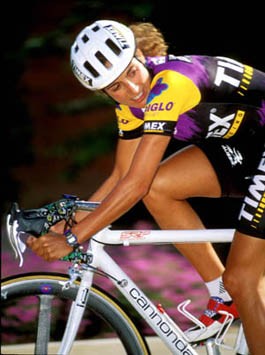N ow in its third year, the Tour of California has become the biggest stage race in the United States, and it’s right on our doorstep. Starting with a 2.2 mile “prologue” on Feb. 17 at Stanford University and racing 600 miles to Pasadena over eight days, this world-class cycling race features elite professional teams competing for the highest prize purse of any cycling race in North America. But until this year, the Tour of California has not included women.
New this year is that the first stage of the race will be held in conjunction with a women’s criterium in Santa Rosa. A criterium, a closed-course loop, is one of the best bike races to watch. Instead of waiting for hours to see the peloton whiz by in 30 seconds, as is generally the case for stationary spectators during a road race, riders pass by the crowds every few minutes. As the first race weekend in the National Race Calendar (NRC), this women’s race will be the place for many domestic racers to fan their feathers, check out the competition and get a feel for the season to come.
With a strong concentration of top U.S. women cyclists living and training in the Bay Area, race director Laura Charameda, a former professional cyclist, says, “We’re hoping for a full field.” (In her day, Charameda won more races than any other American woman.) “Some people are going to walk away with big money from this race and be the leader of the NRC,” she adds. The prize purse for this criterium is $10,000, so spectators can expect to see some serious in-race tactics.
In fact, it’s all about strategy. During a criterium, or “crit,” teams use their strengths to position their sprinter in the best possible place—that is, if the team has a sprinter. If the team doesn’t have a sprinter (someone who is generally larger in size and good at going really, really fast over short distances), the team will be more aggressive during the race, staging “attacks” to try to establish a breakaway.
“These attacks are often timed right after a prime,” Charameda explains. (A “prime” is a sprint lap where the first rider over the finish wins a prize.) “After sprinters go for a prime, they’re tired, so often other teams will use the tired riders in front, sneak around them and make a break before anyone else has time to notice.”
A good place to watch these tactics taking place, says Charameda, is on the back side of the course, on Third Street opposite from the finishing stretch and near the “booster” tent. The “pits,” where team mechanics fix broken bikes on the fly, are also on the back side of the course; this year, they’re on Fourth Street near the Big O Tires outlet.
After the hour of top-notch professional women’s racing, the men will finish their first stage in downtown Santa Rosa. “Next year, I’d love to see up to three of the stages including women,” says Charameda.
Favorite to Take the Win 2007 NRC Overall Individual Winner Laura Van Guilder from the Cheerwine Women’s Professional Cycling Team will be defending her title at 2008’s first NRC race.
Watch Out For Shelly Olds, a young rider being developed by Marin’s Proman Women’s Cycling. Katheryn Curi (Webcor Women’s Team), who was the 2005 U.S. National Road Champion, will also be a contender for the win. Curi says, “For the past two years I have watched the men from the sidelines and now look forward to joining other strong Northern California women to compete in the Santa Rosa criterium.”











